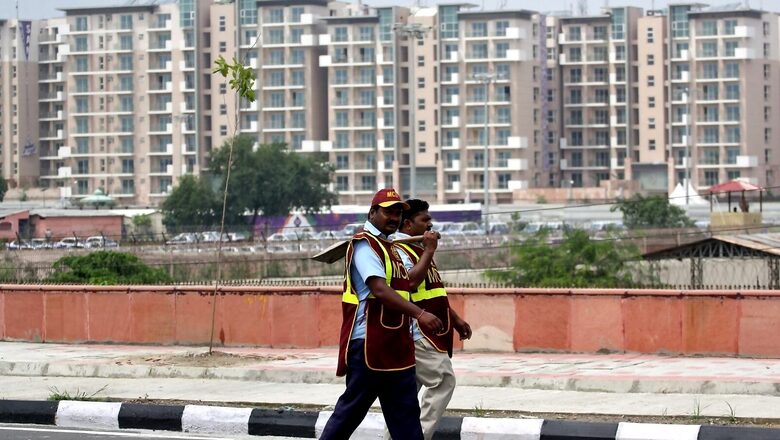
views
The three civic bodies in the national capital were officially merged into the ‘Municipal Corporation of Delhi’ on Sunday. The bodies, which had earlier existed as south, north and east Delhi municipal corporations have now been unified into a single entity, after the ministry of home affairs issued a notification in the regard this week.
But what does this mean? News18 explains:
Why the Unification?
“In exercise of the powers conferred by sub-section (1) of Section 3 of Delhi Municipal Corporation (Amendment) Act, 2022, the central government hereby appoints the 22nd day of May 2022 on which Municipal Corporation of Delhi shall be constituted,” the notification by the Home Ministry had earlier stated.
The erstwhile MCD was trifurcated into three civic bodies -= South Delhi Municipal Corporation (SDMC), North Delhi Municipal Corporation (NDMC), and East Delhi Municipal Corporation (EDMC) — in 2011 through the Delhi Municipal Corporation Amendment Act, 1911 (Delhi Act, 12 Of 2011).
However, this trifurcation of the corporation was uneven in terms of the territorial divisions and revenue generating potential of each corporation. As a result, there was a huge gap in the resources available to the three corporations, vis-a-vis their obligations.
The gap then widened over a period of time, increasing the financial difficulties of the three civic bodies, leaving them incapacitated to make timely payment of salaries and retirement benefits to their employees and thereby creating serious impediments in maintaining civic services in Delhi.
How Will It be Done?
The planned unification of the MCDs’ first administrative step would be to nullify their boundaries. “Unlike the MCD trifurcation in which fresh maps had to be drawn, now one has to just declare that it all comes under one corporation,” Indian Express quoted a senior BJP leader as saying.
The next stage would be to unite the three bodies’ workers under one roof. While the number of lower-rank employees will remain stable, the number of higher-rank positions may decline by a third, the report stated. In the unified corporation, for example, instead of the existing three directors, one for each of the three MCDs, there will be one director for each department such as horticulture, sanitation, education, health, and hospital. Commissioners, committee chairs, and mayors will all be held to the same standard.
Meanwhile, a special officer was appointed to discharge powers of the unified MCD. The MHA on Friday appointed IAS officer Ashwini Kumar as the Special Officer and Commissioner of the unified Municipal Corporation of Delhi.
It also appointed Gyanesh Bharti, an IAS officer of 1998 batch of AGMUT cadre.
Point Is to Lower Costs, But What are the Challenges?
Administrative reforms were highlighted as one of the reasons for the MCD’s trifurcation. However, observable reforms are either absent or insufficiently obvious. At the same time, after the MCD was divided, administrative costs skyrocketed.
Three mayors, three commissioners, 12 additional commissioners made up the bodies. This had increased the expenses manifold and is one of the major contributors to the financial crisis of the MCDs. Experts hope unification will curtail the office and meeting expenses along with the expenses which are being done by the leaders and officers.
“The idea behind the trifurcation was a decentralised corporation but in reality, it was already decentralised as there are 12 zones in the three corporations, which would continue to be even if it is merged,” K S Mehra, the last commissioner of the unified corporation from February 2009 to May 2012 had earlier told the Indian Express.
But a senior official of the South Corporation told the Indian Express that consolidating offices ‘would not result in significant financial savings for the MCDs’. According to him, commissioners’ annual salary would be around Rs 25 lakh and that ‘there would be a maximum savings of Rs 50 crore if the mayor’s office, standing committees, and other heads were reduced to one from the existing three. This is insufficient to preserve MCDs from the financial catastrophe, he said.
The three corporations’ combined yearly revenue is roughly Rs 6,700 crore, whereas their total annual salary and pension cost for their combined 1,60,000 employees is around Rs 8,900 crore. “By reducing the number of personnel and renting out part of the empty spaces, the civic body would be able to save roughly Rs 200 crore if the corporations were merged,” a senior official told the Indian Express.
Yogendra Singh Mann, the former director of the North MCD’s publicity and information wing was quoted as saying that the unification had many other benefits besides money. He said resources, income, and expenses would be balanced. “North currently experiences salary delays on a regular basis; after that, there will be uniformity,” he said.
He also stated that planning would be improved because there would be a centralised authority in charge of parking fees, property taxes, and new local initiatives.
Power Tussle to Die Down?
According to reports, MCDs have claimed they are kept from funds because the AAP-led Delhi government has been blocking it. The MCD’s trifurcation in 2012 was perceived as a move by the Congress to “decentralise” the civic body, as well as a bid by the BJP to seize control in one or two bodies that the BJP had been winning for a long time, reports said.
Arti Mehra, a BJP leader who served as mayor of Delhi from 2007 to 2009, told the Print that the BJP has always opposed trifurcation.
“We were against Sheila Dikshit’s trifurcation of the civic body. The goal was political: to gain traction in at least one or two MCD zones and weaken the BJP’s grip on power by limiting the mayor’s authority. Sheilaji’s non-confrontational tactics, on the other hand, prevented difficulties like those seen under the Kejriwal regime,” Mehra said, adding that “the position of mayor was powerful during my time, but after trifurcation, its weight and importance diminished.”
The BJP now has a laundry list of complaints about how the AAP government in Delhi is impeding civic bodies’ ability to function, including denying funding allocated to them. Many employees had not received their salaries as a result, according to BJP workers. Employees went on strike ten times last year, usually over non-payment of dues.
CM Kejriwal’s Opposition to Move
Earlier, the government had postponed the announcement of the elections to the civic bodies hinting that these three bodies will be merged.
Calling the postponement of the MCD elections a threat to the nation’s democracy, Delhi Chief Minister Arvind Kejriwal said that this was the first time the Centre had written to the State Election Commission to postpone polls.
He also asked the government what were they doing all these years if they so urgently wanted to merge these civic bodies into one.
He also said that the government wrote to the EC few hours before the poll schedules of the MCD elections were to be announced.
Read all the Latest Explainers here

















Comments
0 comment